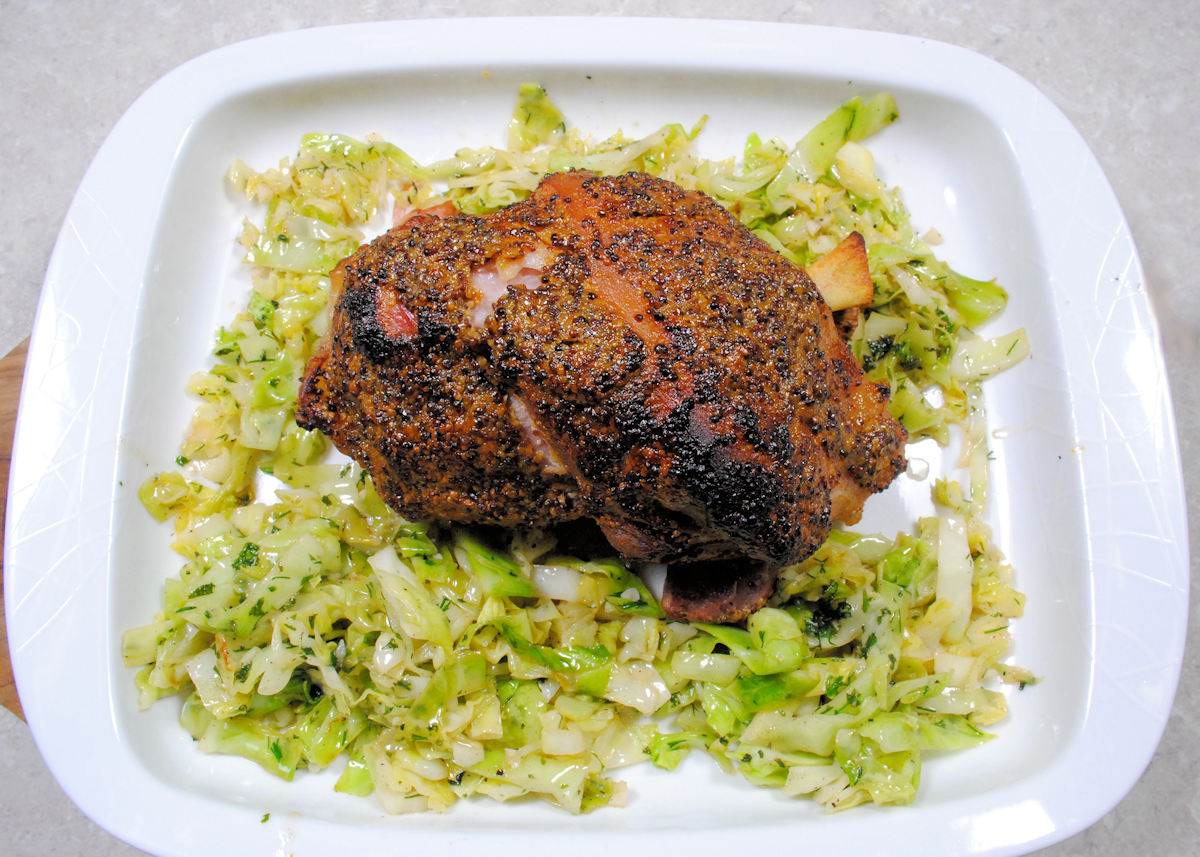Gammon is cured pork; ham is cooked gammon. Let's put this issue to bed now and take a look at this glorious roasted gammon hock.

Ham or gammon?
On Boxing Day, if you're of the traditional orientation and serve ham, there is always someone to ingeniously ask: 'so what's the difference between ham and gammon?' Eyeroll. Sigh.
Why does nobody ever ask about the difference between pork belly and bacon? Perhaps because a lot of people think that bacon comes from a different type of animal than pork. That's a joke, but not entirely: I've come across thus thinking individuals.
The bone appeal
There is something appealingly primeval about eating a piece of animal leg on the bone. You picture yourself as a medieval squire, waving the whole joint of meat about before greedily biting into the fat, spitting out gristle, washing it down in a very slurpy manner with a goblet of rich wine.
Which is where shanks come onto the scene as chicken drumsticks are far too dainty for the experience.
Of course a shank is slightly too large to wave about and probably too substantial for one by modern standards - and where on earth can you get hold of a goblet? But it's great to share, with no waving.
Lamb shank trumps pork shank?
Lamb shanks reign over the Eastern Mediterranean and everyone comes back from holidays rushing to the butcher's for a nostalgic piece of sheep. Why, oh why is poor pig the underdog?
Pork shank (gammon, gammonn, gammmmonnn...) is every bit as nice as lamb and more: it's less gristly, fattier in a nice way and the lean bits are tenderer. And it will fall off the bone just as easily if you treat it well.
How to cook gammon hock?
There's a bit of fat and rind on the gammon hock but also plenty of those round lean succulent muscles nestled around the bone. As all lesser cuts, it does not need a lot of hands-on attention but only time. It will need soaking first, and that's not to get rid of the saltiness which purpose it served in the past, but for initial tenderising.
Then the boiling stage, with aromatics, for about three hours on gentle simmer. For best results leave it to cool down in the cooking liquid - overnight if possible - before blasting it in a hot oven with a classic sticky mustard glaze.
And that is it. Ham hock (as it will now be called as it has been cooked) or shank or knuckle is actually tastier than boneless gammon - and what a nice low price label it bears.
How to make plum sauce for gammon
I know, I know – no matter what you call it (ham or gammon), the traditional accompaniment is parsley sauce. I don’t like it. I bet you don’t like it. And least of all, no kids ever like it.
I much prefer a riff on the other traditional sauce, Cumberland. It is quite involved though, boiling citrus peel, whisking and straining, port and redcurrant jelly and it’s more suited for Christmas than the rest of the year.
My suggestion is a simple plum sauce, made with either fresh or frozen plums.
You start it like jam, cooking down plum chunks until they start to break down, with cinnamon, a pinch of chilli powder, and a handful of raisins because why not.
Then you dilute it with the gammon cooking liquid, add some lemon juice and season it to taste. Chunky, delicious, and the perfect complement to the ham. Gammon. The meat.
More gammon recipes
Cider braised gammon joint with apples and garlic, slowly cooked in the oven. The best cooking method for a great ham roast or sensational ham sandwiches.
Butter beans with ham hock, a slow cooked stew of incredible flavours and richness, the ultimate comfort dish. Butter beans need soaking overnight, but what’s difficult about that?
Baked beans with bacon are called b-b-beans in my house. Dried beans soaked overnight, slab bacon or gammon, molasses and mustard, five hours cooking – beat that, Mr Heinz!
More pork roast recipes
Braised pork shoulder with chillies and cumin, Mexican style flavours. Beer braised pork shoulder joint takes four hours to cook in the oven and the result is pork so tender it can be pulled or shredded.
Porchetta, classic Italian pork roast, prepared with the easiest cut to handle: pork collar, also sold as neck or shoulder. Served usually cold in bread rolls, it is also gorgeous as a roast.
Pork loin roasted at low temperature, served with blueberry sauce. Low temperature roasting makes for fantastic succulent meat and the blueberry sauce is the best for pork.